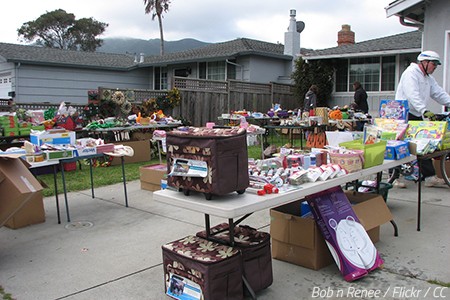 A house move within the same state (in-state move) will always be easier and cheaper than a cross-country move primarily because of the much shorter distance between the two homes.
A house move within the same state (in-state move) will always be easier and cheaper than a cross-country move primarily because of the much shorter distance between the two homes.
Nevertheless, moving locally should not be underestimated as it requires the same amount of meticulous preparation and careful planning as moving long distance, if not more in some relocation cases.
Be aware that regardless of whether your breakable and fragile items will travel 100 miles or 1,000 miles, they still need to be well-padded and safely packed in strong boxes in order to reach the new home unscathed.
The same is true for a number of organizational tasks as well – no matter how close or far you’re moving, you still need to change your address with the USPS and transfer the home utilities on time.
And, of course, you should never forget the ultimate goal of lowering moving costs whenever possible.
Here are the top 10 local moving tips that should make your local move much easier.
1. Have a good local moving plan
The very first thing you need to do when you already know for a fact that you’ll be soon moving locally is to create some sort of a plan in your head.
Playing it by ear is a bad idea, especially if you’re moving out for the first time. So, instead of improvising, find a bit of time to create a master plan of how your local move is going to pan out.
However, if planning a local move is a luxury you can’t afford due to severe time constraints, then take advantage of a local moving checklist that will guide you throughout the in-state move.
Moving Checklist: Interactive & Printable
2. Make an informed decision: DIY or movers?
When moving locally (a move radius of roughly 100 miles), you’ll have a good opportunity to organize a self-move and potentially save some money in the process.
DIY moves are suitable when moving locally but a number of minimum requirements will have to be met so that brave attempts at self-moving can work out well in the end:
- Previous house moving experience;
- Reliable friends who are ready to give you a hand and who won’t back out at the last minute;
- No specialty items – a piano or a pool table, for example – that require special packing care that only professional packers can provide.
Hire Movers or Move by Yourself?
3. Know how much local movers charge
It’s important to remember that while cross-country movers charge a flat fee calculated on the basis of various factors such as shipment weight, move distance, and moving services, local moving companies charge by the hour.
On average, hiring 2 movers and a truck for a local move will cost you between $90 and $120 per hour. Of course, the exact charge will vary depending on where you live in the country (state, big city, small town, rural area) and the local moving company you pick as your partner.
When moving locally, time becomes the major factor that will determine how much your in-state moving company will charge you.
How Much Does It Cost to Hire Movers?
4. Learn the price of your own local move
It can be useful to know the average cost of moving locally but it’s even more useful to know the cost of your own move. And the only way you can get that critical piece of information is to get cost estimates in writing from top-rated local moving companies.
The only way to learn the cost of your own local move is to get free moving quotes from several reputable local movers and compare those price estimates to pick the offer that fits your moving budget and satisfies your relocation needs.
5. Hire the best local movers near you

Don’t settle for less than the best local movers.
Once you have the moving cost estimates in your hands, it should be fairly straightforward to choose which local moving company to trust with your valuable possessions.
First of all, you should look at the final estimated costs and whether or not they include the extra moving services that you need or want.
And secondly, you just have to do your homework and research the moving companies so that there won’t be any unpleasant surprises later.
And what’s the first step of researching local moving companies?
Read genuine customer reviews about the short-distance movers, of course.
How to Find the Best Local Movers Near You
6. Decide who’s going to pack your things
Without a doubt, packing for a local move is one of the most important tasks in your moving checklist, if not the most crucial one. And here’s the question that you need to answer pretty early in your preparation:
Will you pack up your things by yourself or will you hire professional packers?
As is the case with most move-related decisions, there are pros and cons no matter which option you choose.
Professional packers will wrap up and box your prized possessions quickly and safely but professional packing services are not cheap. On the other hand, you should be able to pack up most of your own things but it’ll cost you plenty of time and effort.
7. Start packing for a local move TODAY
Once you make up your mind that you can manage the packing process without hiring professional packers, it’s time to get down to it without any delay.
One of the best local moving tips you’ll ever get is to start packing ASAP. The main reason for that sense of urgency is simple – packing for a move is the most time-consuming task in a moving checklist. And so, to make sure you’ll be done with packing before Moving day arrives, you just have to initiate the packing project right away.
Procrastination when packing for a local move is a really bad idea.
How to Motivate Yourself to Pack for Moving
8. Follow a packing timeline
At first, it can be rather confusing when you start packing up your things simply because you may not know where to start. Should you pack up the kitchen first, or should you start the packing task from the closet?
Also, if you’ve never packed for a local move before, you’re likely to lose loads of valuable time deciding what to do next once you’ve tackled a packing task.
The thing is that you simply can’t afford to lose precious time while wondering what you’re supposed to pack next. So, do yourself a favor and follow a detailed Packing Timeline to control the entire packing process from start to finish.
Packing Checklist: Packing Timeline for Moving
9. Get hold of the proper packing supplies
The thing is that you can’t pack by yourself if you don’t have the right packing materials, right? Not surprisingly, your packing checklist should remind you to find the right type and number of packing supplies beforehand so that you won’t have to interrupt the house packing process once you’ve started it.
Bear in mind that you surely don’t have to buy all packing supplies brand new, especially when it comes to cardboard boxes. Why should you pay hundreds of dollars for new moving boxes when you can get most of them for free?
Besides packing boxes, you’ll also need plenty of packing paper and bubble wrap to protect your fragile items. Packing tape and permanent markers are must-haves too.
Where to Find Free Packing Materials
10. Inventory your home

Inventory your entire home so that you know what you’re up against.
Creating a home inventory is one of those tasks that you somehow feel you can skip and still be ok in the end. Well, don’t skip it.
A detailed home inventory will give you valuable information about what household items you have under the roof. People often get surprised when they uncover things they have completely forgotten about when getting ready to move out. And you might feel that way too.
Go from room to room and write down on an inventory sheet all the things there. Later, you’ll use that inventory list to decide which items you’ll be moving to the new home and which ones you’ll be leaving behind.
How to Make a Home Inventory When Moving
11. Decide what to do with your furniture
One of the biggest questions when moving locally is whether you should move the furniture with you.
Now, moving furniture across the country is rarely worth it due to the high transportation costs. However, when moving locally, taking some furniture pieces with you could prove to be a good idea.
If you’ve got antique furniture or one that has sentimental value for you, then yes, moving it should make sense. On the other hand, paying for the haul of large and heavy furniture items, or ready-to-assembled ones such as IKEA furniture is often not worth the trouble at all.
Should You Move Your Furniture or Buy New After the Move?
12. Create a layout of the new home
A floor plan of the new place can definitely help you decide what items you should take with you and what items you’ll be better off just leaving behind. In fact, the idea of creating a layout of the new home is especially relevant when it comes to moving large furniture between the two locations.
If possible, create a floor plan to figure out the angles. You may find out that there just isn’t enough space in the new home for some of the larger items you intend to move. Or maybe their design and color will not really fit the décor of the destination place.
13. Lighten the load
Another thing you should do when moving locally within the same state is to declutter your home with the purpose of moving with you only the things you intend to use in the near future.
The thing is that the more items you take with you, the more money you will pay for their transportation. And besides, some of those things will have become useless, broken, and ultimately unwanted with time so there’s really no need to move all of them to the new place.
Sell at a garage sale, give away to friends, donate, or just throw away (recycle) the household items you no longer care about.
How to Get Rid of Stuff Before Moving
14. Pack with safety in mind
Your decision to pack by yourself means that you must feel confident in your overall packing skills. And unless you have specialty items that require special packing and handling, you should trust yourself to complete the packing process without hiring professional packers.
And as you might suspect, one of the big challenges when packing on your own is safety.
- Double-tape the bottoms of your cardboard boxes, especially if you’re using second-hand containers.
- Use packing paper and bubble wrap generously throughout the packing task – these are the padding materials that will ensure your breakables reach the new home in one piece.
- Fill any gaps inside the boxes with paper to make sure the items inside will not shift during transport.
The 20 Best Packing Tips for Moving
15. Prepare an essentials box

Load your essentials boxes last in the car and unload them first when you reach your destination.
Even though you won’t be moving across the country, you’ll still face a period when you won’t have full access to your everyday items since they will be already packed up and possibly even in transit at the time.
One of the best packing tips for moving locally is to prepare an essentials box and keep it with you throughout the move.
All you have to do is pack up items of absolute necessity such as prescription medicines, important documents, personal hygiene items, an extra set of clothes for each family member, some essential kitchen items, some basic hand tools, children’s items, pets’ items, and so on.
How to Pack an Open First Box When Moving
16. Transfer the utilities
Even when you’re moving only a short distance away, you’re still going to have to take care of a number of organizational tasks that are directly connected to the process of moving house.
The first such task concerns the transfer of your home utilities – after all, you’re leaving the current place and you’ll no longer be using them. Therefore, contact the utility companies and schedule the disconnected of the utility services there – water, electricity, cable TV, gas, landline phone, and so on.
Also, get in touch with the utility providers in the destination town or city and arrange for reconnecting those house utilities shortly before you move into the new residence.
How to Change Utilities When Moving House
17. Change the address
One thing you may forget when moving locally is to change your address so that you keep receiving your important mail.
The idea is simple enough – you’re moving to another house or apartment so your postal address is changing too. And yet, in the midst of a whirlpool of moving tasks, you can easily forget about changing your address with the USPS prior to moving out.
The good news is that you’ve got plenty of options to change your address when moving locally:
1) online on the official USPS website,
2) in person at the nearest post office,
3) over the phone, and
4) by mail (of course!).
How to Do a Change of Address When Moving
18. Know how to pack your car
Since you’re moving within the same state within a move radius of roughly 100 miles, it’s almost certain that you’ll be driving your own car to the new home. Therefore, you have to be sure that you know how to pack your vehicle in a way that you can fit more items inside it and will not endanger the short car trip in any way.
Packing a car for a local move is not rocket science but you should still be careful what items you load into your own vehicle and how you arrange them so that you can maximize the storage space inside the car.
How to Pack a Car for Moving: 13 Car Packing Tips
19. Keep children and pets safe
The day of the actual move can be rather dangerous for young children and pets so you must stay proactive and avoid possible trouble by making sure your loved ones are as far away from the moving action as possible.
Moving day is definitely not the right time for small feet to be running around unchecked, so ask a trusted person to look after your kids and pets while you help your local movers or move heavy boxes around with your friends in the case of a Do-It-Yourself move.
Don’t forget that, throughout the local move, the health and wellbeing of your family members is your number one priority.
10 Mature Tips for Moving with Children
20. Reduce your local moving costs

Save money by packing by yourself. And yes, packing for a local move is a joint family effort.
You may happen to like some local moving tips and dislike others, but when it comes to advice that will help you reduce moving costs, then you’d better take it, for it’s your hard-earned money that will be at risk throughout your local move.
Luckily, there are numerous ways to lower local moving costs, and here are the top 5 cost-saving tips you should use to your advantage:
- CONSIDER organizing a DIY move if all self-moving requirements are present. If not, then
- CHOOSE a low-cost local moving company to transport your household items;
- REDUCE the number of your items prior to packing to speed up the entire move;
- GET free moving boxes and free packing materials to minimize the packing cost;
- PACK your things on your own to avoid having to pay for professional packing services.
20 Simple and Easy Ways to Reduce Moving Costs
The post 20 Local Moving Tips: Local Moving Checklist appeared first on The Moving Blog.







